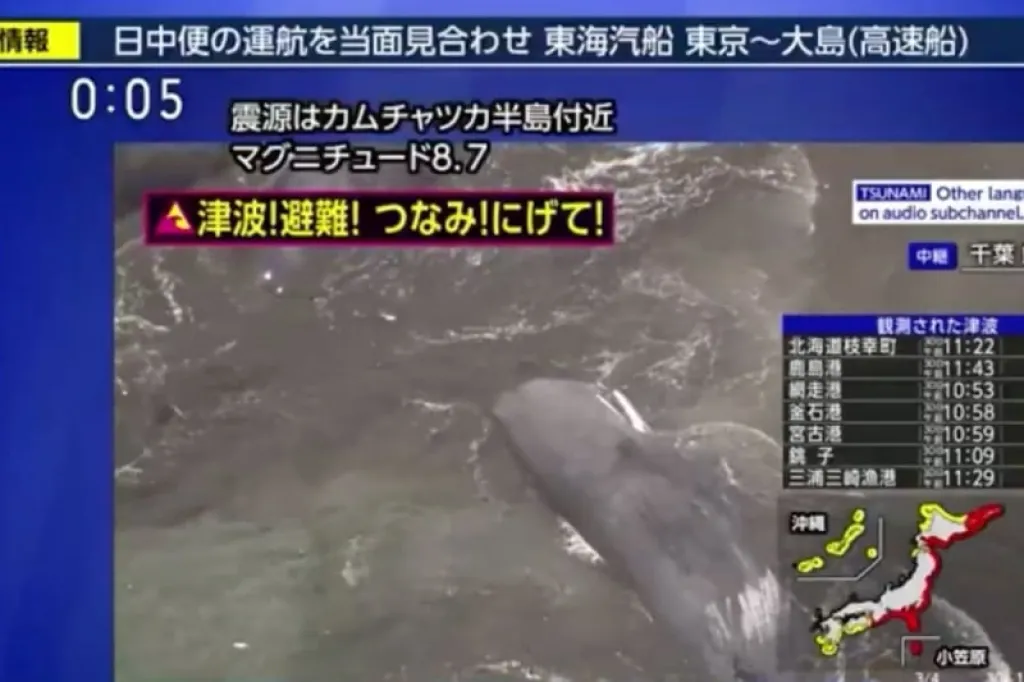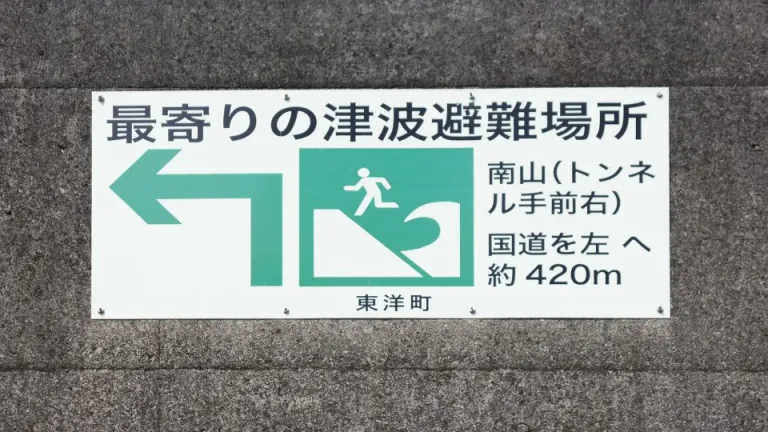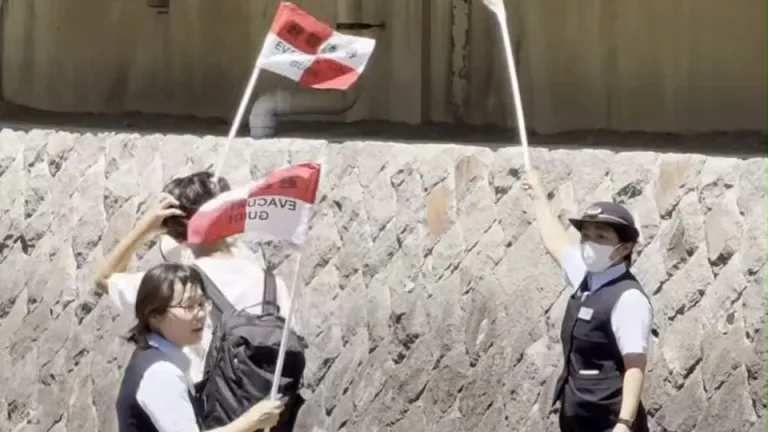What It’s Like to Face a Tsunami Warning in Japan?

Imagine it’s a calm morning in a coastal Japanese town. You’re making breakfast, the streets are quiet, and then suddenly your phone buzzes, sirens wail, and a tsunami warning flashes across your smartwatch. What happens next?
For most people, it’s an unimaginable scenario. Personally, living in India (coastal Karnataka), I’ve never experienced an evacuation like this which is why Japan’s tsunami preparedness fascinates me so much.
The Reality of Tsunami Warning in Japan

Recently, content creator Yuu (@yuus.adventure) shared his first-hand experience during a tsunami warning in Kamakura, giving us a rare inside look at how Japan handles such emergencies.
“I Live About a 10-Minute Walk From the Ocean…”
It was just before 10 a.m. when the alert came in. Yuu was making pancakes when his smartwatch displayed the warning.
“Since I live close to the sea, I first stepped outside to check the situation. I saw people walking and running with large bags in my usually quiet neighborhood. Seeing others evacuating, I realized that I needed to prepare quickly and evacuate as well.”
Within moments, his peaceful Kamakura neighborhood transformed. People with backpacks and large bags were moving quickly toward safer ground. Evacuation officials carrying flags were directing them toward a designated safe zone, a nearby middle school.
How Tsunami Evacuation Works in Japan?
Japan’s tsunami evacuation process is one of the most organized in the world. Here’s how it typically unfolds:
Immediate multi-channel alerts: Residents receive warnings through smartphones, smartwatches, public sirens, loudspeakers, TV, and radio.
Pre-mapped evacuation routes: Coastal communities have clearly marked pathways leading to higher ground or evacuation centers.
Designated shelters: Schools, community centers, and other sturdy buildings are prepared to house evacuees.
Guided evacuations: Authorities use flags, vests, and megaphones to direct people to safety.
Most importantly you should get to safety quickly, don’t wait to see what happens.
How It Differs From Evacuation Systems in India?
This organized, drill-like approach is what sets Japan apart. In countries like India, while coastal states also issue tsunami warnings and evacuation orders, the on-ground experience is often different -- community drills are less frequent, public awareness isn’t as widespread, and real-time communication systems aren’t as integrated into everyday life.
Having personally never experienced such a large-scale evacuation myself, Yuu’s account highlights just how structured and disciplined Japan’s disaster response can be compared to what many of us are familiar with back home.
Also read: Autumn in Japan: Why You Should Plan for September Now
Yuu’s Evacuation Experience
Yuu had only moments to act.
“My priority was getting my pets out safely. I left the pancakes I was making for breakfast still sitting in the frying pan, quickly packed just a little camera gear, and headed to the designated evacuation site.”
At the middle school, evacuees without pets were guided into air-conditioned classrooms. Those with animals, like Yuu, had to wait outside.
He also noticed tourists among the evacuees: “They came here to enjoy Japan, and I couldn’t help but worry that they might have felt scared by the experience. I truly hope they are still able to enjoy their time in Japan and go home with good memories.”
What Should Tourists Do During a Tsunami Warning in Japan?
 Image credit: YUU via IG (Screen Grab)
Image credit: YUU via IG (Screen Grab)
If you’re visiting Japan and a tsunami alert is issued, here’s what you should do:
Follow locals – Head in the same direction as residents; they know evacuation routes.
Move to higher ground – Get as far inland and as elevated as possible.
Obey officials – Look for people with flags, safety vests, or megaphones.
Travel light – Don’t stop to pack luggage; speed is your priority.
Stay informed – Keep your phone charged for live updates.
Takeaways from Yuu's evacuation experience
“Through this tsunami warning experience, I realized I need to be much more prepared for disasters. I plan to create a checklist for things to bring in emergencies -- like food, water, and pet supplies -- so that I can act quickly and calmly next time.”
This personal takeaway mirrors Japan’s culture of preparedness: every warning is treated as urgent, every evacuation is executed with precision.
Also read: Cute Souvenirs You should get home from Japan - Indian Travelers Guide
FAQs About Tsunami Evacuation in Japan
1. I’m a tourist in Japan, how will I know if a tsunami warning is issued?
Tourists receive the same alerts as residents through smartphones, public loudspeakers, and sirens. Even if you don’t speak Japanese, the emergency notifications often include simple English instructions.
2. What should I do if I don’t know the area?
Follow locals immediately. Evacuation signs are also marked in English, and officials use flags and hand gestures to guide people.
3. Can I bring my luggage?
It’s best to leave large suitcases behind. Travel light and prioritize speed. Essential items like passports, wallets, and phones should be carried.
4. Are tourists allowed in evacuation shelters?
Yes. Schools and community centers welcome everyone, including tourists. If you have pets or oversized luggage, you may need to wait outside designated areas.
5. Will language be a problem?
Not usually. Many evacuation instructions are bilingual, and staff or volunteers often provide basic guidance in English or through gestures.
Published at
About Author
Subscribe our Newsletter
Get our weekly tips and travel news!
Related Posts
10 Amazing New Attractions in Singapore - Indian Travelers Guide 2025
Explore the new yet amazing attractions of Singapore
10 Best Beach Resorts in Karwar Karnataka - 2024
Escape to the tranquil beaches of Karwar, Karnataka, where luxury resorts offer a serene retreat amidst nature's pristine beauty.
10 Best Places to Visit in Mahabalipuram, Tamil Nadu
Explore the 10 Best Places to Visit in Mahabalipuram, Tamil Nadu – where ancient temples, rock-cut sculptures, and serene beaches meet!
10 Common Mistakes Every Traveler Makes
Indian travelers often overpack, skip travel insurance, and neglect local customs. Embrace light packing, smart planning, and cultural respect for a smooth and unforgettable trip.
10 Cool Summer International Destinations
Beat the Indian heat with these 10 cool summer international destinations that promise refreshing getaways and unforgettable experiences.
Latest Posts
5 Motorcycle Rental Routes in Ladakh for Enfield Enthusiasts in 2026
From Nubra Valley to Pangong Lake, explore the best Ladakh motorcycle rental routes for Royal Enfield riders planning a 2026 trip.
5 Houseboat Dinners in Alleppey for a Magical Christmas Eve
Celebrate Christmas Eve in Alleppey with top 5 candlelit houseboat dinners, festive Kerala cuisine, and serene backwater cruises. Discover the best options here.
7 Secluded Beach Resorts for New Year Couples Retreat
Planning a romantic New Year escape? Discover 7 secluded beach resorts in India perfect for couples seeking privacy, ocean views, and peaceful celebrations.
7 Organic Cafes in Pune with Farm-to-Table Menus for Health Lovers
Pune's top 7 organic cafes! Fresh, farm-to-table eats for guilt-free indulgence. Yummy, healthy, and supports local farms!
Australia Bans Social Media for Kids Under 16 in December 2025
World's first nationwide social media age restriction affects family travel and youth tourism globally.

